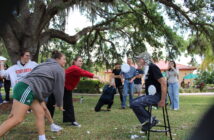In this era, technology is constantly changing. Sometimes, however, it changes faster than the law, and new regulations sometimes don’t come out until several years following the technology’s discovery.
For the past couple of years, the Department of Transportation (DoT) and Federal Aviation Administration (FAA) have been working together to try and figure out exactly what to do about civilian unmanned aircraft, often referred to as “drones”. Even though they are not exactly big, drones can still cause a lot of trouble if either flown too high, which disrupts documented air traffic, or over certain areas, such as military bases and airports.
The FAA, who regulates airspace boundaries, seek to keep drones under a certain altitude and out of restricted airspace. These regulations were put into effect as of Aug. 29, 2016.
According to official FAA documents, airspace is divided into different “classes”; Class G, which is the closest to the ground (anywhere 1,200 feet above the ground or lower) is generally unregulated. Since most commercial or military aircraft do not fly that close to the ground, there is no requirement for the same constant radio communication with Air Traffic Control (ATC) that pilots who fly above a certain altitude have to worry about.
With the new regulations, drone pilots will not have to worry about having to contact ATC for permission to fly their drones as long as they are flying within Class G airspace. Although they are unregulated, pilots will still have to register their drones as long as the drone is over 0.55 lbs. and under 55 lbs., according to the rules of the FAA’s Fly for Fun act. Also, registration costs $5 for a three year registration and must be done by a United States resident over the age of 13. Certain safety guidelines still apply and can be reviewed on the FAA’s website.
Larger unmanned aircraft, which may have the power to fly above 1,200 feet, require a lot more regulation. If the aircraft is going to be flying into the next classes of airspace, they must have permission from ATC before takeoff, and have almost the same requirements as manned aircraft pilots. If a drone were to get sucked into the engine of a jet or smash into the windshield of a propeller-driven aircraft, it could prove disastrous for the manned aircraft and its pilot(s) and passengers as well as any bystanders.
For this very reason, unmanned drone pilots must fill out a form online, which acts as a request for permission to enter controlled airspace. Approved applications will be forwarded to local ATC towers later in the year, starting in early October, with lower class airspace applications getting accepted faster. The FAA urges future requests to be sent in at least 90 days in advance before users fly into controlled airspace.
Alongside registering a drone with the FAA, submitting controlled airspace requests, and contacting ATC towers before takeoff, pilots must also take a test in order to be certified to fly into controlled airspace. Pilots who become certified will receive a temporary certificate emailed to them, good for 120 days. During this time, the FAA will mail the actual certificate, which is good until it expires. A pilot must be 16 years or older and have one of these certificates in order to fly a drone. If the pilot is under 16, he or she must be supervised by someone 16 and older with one of the certificates.
What does this mean for Saint Leo? On campus, drones are allowed, but students are expected to adhere to these new laws. If a student has a drone, or plan to get one for his or her birthday or holiday, he or she or a parent, will need to register it with the FAA and will need clearance before flying above 1,200 feet. As one Youtuber showed before his video was removed (because what he was doing was not only unsafe, but also highly illegal), he was able to fly any standard off-the-shelf drone to a ceiling of about 11,000 feet.
In order to better inform the public about all of these new rules and regulations, the FAA has put out an app called “B4UFly” and anyone who still has questions to ask should download it. The app also includes built-in features, such as a map showing restricted zones, being able to plan out flights before taking off, and locating nearby airports and pinpointing their exact distance to the user. Drone pilots are required by these new regulations to alert air traffic control if they will be flying a drone within five miles of an airport.
Any further information on these new laws and regulations, including step-by-step guides, can be found at www.faa.gov/UAS and general questions can be sent to UASHelp@faa.gov or call 844-FLY-MY-UA.




